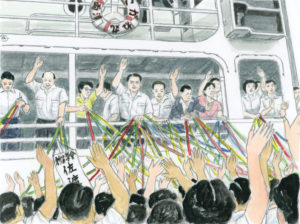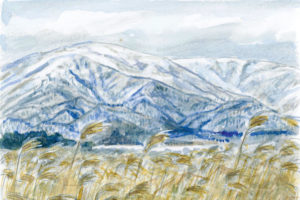Chapter Summary

Illustration courtesy of Seikyo Press.
The Soka Gakkai forged ahead into 1967, the Year of Dynamic Advancement, where they would mark the seventh anniversary of Shin’ichi Yamamoto’s inauguration as third Soka Gakkai president. At the end of November 1966, the organization surpassed six million member house-holds. Shin’ichi was firmly determined to make this new year one of incredible growth in the kosen-rufu movement.
On January 9, Shin’ichi visited Kansai, then moved on to Hokkaido, Kyushu and the Chugoku regions among others, crisscrossing the entire country in just two weeks. It was an intense struggle without a moment’s rest.
At the end of January, the Clean Government Party (Komeito) entered its first Lower House election where they won 25 seats. With this victory, the Clean Government Party leapt to the position of the fourth-ranking party in the Lower House.
On March 4, Shin’ichi attended the opening ceremony for the Chugoku Culture Center, which was the Soka Gakkai’s first culture center. Shin’ichi believed that kosen-rufu was a movement for the creation of a truly humanistic culture. He also felt it was important that Chugoku—which embraced the city of Hiroshima, the site of the world’s first atomic bombing—become a transmission point for the supreme life philosophy for realizing lasting world peace.
On April 22, Shin’ichi visited Niigata Prefecture. There, he met with members from Sado Island and vividly recalled his visit to the island nine years earlier. At that time, Shin’ichi reflected on the life of Nichiren Daishonin and remembered how he had vowed to dedicate his life to kosen-rufu with the same determination that he had, remaining undefeated in the face of any hardships.
Unforgettable Scene

Illustration courtesy of Seikyo Press.
Strive Amid Difficulties With the Heart of a Lion King
On April 22, 1967, Shin’ichi Yamamoto visited Niigata Prefecture, where he reflected on the struggles Nichiren Daishonin endured on Sado Island.
Even while in exile, Nichiren Daishonin’s thoughts never strayed from his disciples. The fact was that, after his near execution at Tatsunokuchi, a number of his followers had abandoned their faith or had begun to doubt his teachings because they feared the harsh persecution they were sure to encounter …
Some of the disciples who became fainthearted and lost their fighting spirit pointed an accusatory finger at Nichiren, saying: “Though the priest Nichiren is our teacher, he is too forceful. We will spread the Lotus Sutra in a more peaceful way” (“Letter from Sado,” The Writings of Nichiren Daishonin, vol. 1, p. 306). This may seem perfectly reasonable, but it is actually nothing more than cowardice. Rather than challenging their weakness, these disciples shifted the blame to their mentor’s methods of propagation, thereby justifying their own failure to engage in the struggle of a true disciple. Such is the modus operandi of people who grow corrupt and abandon their faith.
Nichiren’s writings from Sado are alive with fatherly strength and compassion that seek to crush the cowardice and weakness in his disciples’ hearts and teach them genuine faith. For example, the following passage from “The Opening of the Eyes” reveals his rock-solid determination to advance kosen-rufu in the face of all manner of obstacles:
“Let the gods forsake me. Let all persecutions assail me. Still I will give my life for the sake of the Law” (WND-1, 280). This was a cry from the depths of Nichiren’s being as he strove to quash the tendency of his easily swayed disciples to view faith as a mere means to gain personal security and receive protection from the Buddhist gods. He wanted to enable them to cultivate a perspective based on genuine faith and develop a boundless state of life …
And he states: “When an evil ruler in consort with priests of erroneous teachings tries to destroy the correct teaching and do away with a man of wisdom, those with the heart of a lion king are sure to attain Buddhahood” (“Letter from Sado,” WND-1, 302). In other words, struggling courageously when one meets great hardship is the key to attaining Buddhahood …
Nichiren himself joyfully expressed appreciation for his persecutors, for without them, he said, he could not have revealed himself as the votary of the Lotus Sutra.
Nichiren’s teaching is one of transforming great adversity into great benefit and realizing supreme value in the process. It is a philosophy of creation that changes human life at the most fundamental level. (The New Human Revolution, vol. 11, pp. 332–35)
The chapter summaries were originally published in the September 4, 2019, Seikyo Shimbun, while the “Unforgettable Scenes” were originally published in the September 11, 2019, issue.
Key Passage
To persevere doesn’t mean simply doing today what we did yesterday. It is to challenge ourselves anew and to make a fresh resolve each day. Faith is a constant struggle against devilish functions, and a Buddha is one who never ceases in that struggle. (NHR-11, 308)
You are reading {{ meterCount }} of {{ meterMax }} free premium articles

